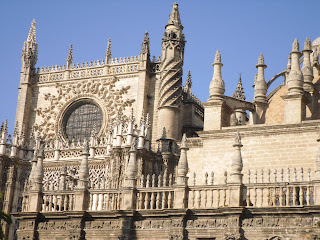


We finally succumbed to hunger, and sought out our first tapas bar of the trip. Word to the wise: ordering tapas when you speak no Spanish whatsoever and one of you doesn't eat pork is not something I would recommend trying without a guidebook to aid you. We were ill-equipped. It didn't help, either, that I don't eat much fish outside of the shellfish family. Yet somehow, with some decent guesswork, a little understanding of English on the part of the waiter, and much gesticulating from all parties involved (a running theme of the trip), we managed to successfully order lunch.
 Once inside, we marvelled at the massive organ and eavesdropped on a tour group long enough to learn that about 15% of Christopher Columbus can be found in the cathedral's Tomb of Christopher Columbus. Also interesting was the permitted sit-in protest by jobless young teachers. We then climbed the many ramps spiralling up the tower for great views of Seville.
Once inside, we marvelled at the massive organ and eavesdropped on a tour group long enough to learn that about 15% of Christopher Columbus can be found in the cathedral's Tomb of Christopher Columbus. Also interesting was the permitted sit-in protest by jobless young teachers. We then climbed the many ramps spiralling up the tower for great views of Seville.

The following day we wandered, hoping to stumble upon the cultural hot spots without being chained to the map. We didn't find much of note until we crossed the river to an area clearly on the periphery, but well worth the journey: there was a random American botanical garden running parallel to the river, which was pretty much deserted. So we happily strolled past fountains and cacti, until we hit road (and civilisation). Luckily for us, the area had something more 'substantial' to offer us, in the form of the Andalusian Centre for Contemporary Arts. The epicentre of this compound of buildings and gardens was a monastery-cum-ceramic factory-cum-exhibition space. We spent the rest of the afternoon here, enjoying a variety of exhibitions on the urban landscape and lifestyle.



After an evening consisting of uber rich hot chocolate and my first ever orchestral experience - complete with Spanish guitar! - we retired to our room embarrassingly early in preparation for our big day out in Cordoba. The main draw of the little city an hour away by train was the Mosque Cathedral - truly one of the most spectacular buildings I've ever seen. As suggested by the name, the cathedral was formerly a mosque (for a potted history of Muslim rule in Spain, please look to Wikipedia, for I am lazy) and retains the original features. Most impressive was where mosque met cathedral, the white walls of the central chapel blending into the Muslim-style arches surrounding it.


Cordoba was very charming and I wish we could've spent longer there, not least because the synagogue and other sites in the Juderia (Jewish Quarter) were closed by the time we found them.


On our last full day, we visited the Alcazar, a royal palace exemplifying Mudejar architecture. We went from room to room, marvelling in each at the intricate detailing on the ceiling, walls and windows.



Being Londoners, we're not really accustomed to restrictive Sunday opening hours, and thus did not factor early closing into our planning for the last day; we arrived at the modern art gallery just as the staff were clearing people out. There seemed nothing left for us to do, except eat more tapas and cake (the burdens we have to bear sometimes...). The tapas bar of choice in our vicinity was what I can only describe as Seville's answer to the New York deli. It was manically busy, with locals barking orders for Cruzcampo beer, montaditos (mini sandwiches), and fried bread topped with pork or fish. It took me ten minutes, four guys behind the counter (two with the patience of saints) and record levels of gesticulating to order our food. For dessert, we picked up some kind of multi-layered cake from a cafe we went to on the first evening, and returned to the Plaza de Espana for eating accompanied by people watching. One final tapas dinner a few hours later brought the holiday to an end.
So that was our Seville trip: a voyage of discovery that I thoroughly enjoyed but still believe would have benefited from a guidebook listing food-related vocab.


















































